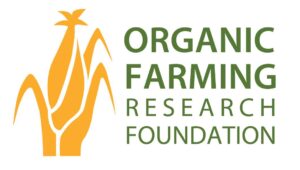Apr 10, 2024
OFRF program supports farmer-led research
Tim and Becky Colby own Colby Farms, a 14-acre farm in Papillion, Nebraska, where they produce vegetables, fruits and some livestock products for their community.
As beginner and veteran farmers, they are in their second year of transitioning a historically conventional farm to organic production. Having previously farmed in Arizona for three years, they came back to Nebraska to tend the land where Becky’s grandfather once farmed.
 The Colbys have exciting plans for their farm. They hope, in time, to create a farm-to-school program, offer value-added food classes and build a commercial kitchen. They hope to establish a fruit orchard with apples, peaches and other stone fruits to offer u-pick, as well as raise chickens, goats, bees and perhaps cows.
The Colbys have exciting plans for their farm. They hope, in time, to create a farm-to-school program, offer value-added food classes and build a commercial kitchen. They hope to establish a fruit orchard with apples, peaches and other stone fruits to offer u-pick, as well as raise chickens, goats, bees and perhaps cows.
The farm is located in a floodplain with clay heavy soil vulnerable to compaction. Decades of conventional corn and soybean rotations have contributed to this problem. The Colbys knew from the beginning that they needed to improve soil structure to produce quality crops. A USDA representative also noticed soil compaction and recommended using deep taproot cover crops to address this challenge.
In their first year at their Nebraska farm, they planted a sorghum sudangrass cover crop, which resulted in a lot of organic matter produced. However, they quickly noticed that the cover crop roots had failed to penetrate the soil beyond the hardpan.
The Colbys had a lot of questions regarding the use of cover crops to reduce soil compaction: What cover crop species should they use? How many cover crop cycles are needed? Would there be any potential weed or pest concerns?
Weed pressure is very high due to continuous use of the same crop rotation in the land for over 30 years. Sorghum sudan appeared to provide very good weed suppression but only after mowing three times. On the other hand, they are concerned about possible infestations of Japanese beetles, which have occurred in the past on soybeans. How would the cover crop respond to such an infestation?
This is where their interest in Organic Farming Research Foundation’s Farmer Led Trials (FLT) Program came in.
Farm trial plan
OFRF staff is currently working with the Colbys to figure out the best way to establish a cover crop comparison trial that can point towards the best cover crop options for reducing soil compaction at the farm. Using a 2-acre area, preliminary plans are to plant a mix of peas, oats and vetch during spring and make the comparison for the fall season using daikon radish, tillage radish, rye and canola cover crops. Preliminary measures include soil compaction, weed suppression and soil nutrient levels through lab analysis.
Tim and Becky know that dealing with soil compaction goes beyond just planting deep-rooted cover crops. They have plans to use reduced tillage practices, and create permanent beds and living walkways in order to minimize soil compaction. All these measures will contribute to a healthier soil structure.
At OFRF, we are excited to be a part of the Colby’s learning journey, and hope that their work will inspire more farmers to conduct research trials on their farms.
This story is part of a series profiling farmers who are taking part in OFRF’s FLT program. Farmers receive seed funding and technical support from OFRF to address their challenges through structured on-farm trials. To learn more about OFRF Farmer Led Trials Program, visit the organization’s website.






